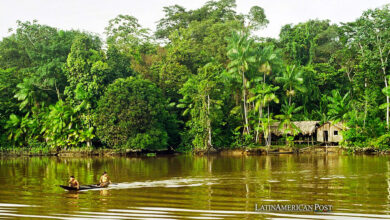Microplastics Menace as Latin America’s Marine Giants Fight for Survival
In Latin America’s pristine waters, the majestic humpback whales and elusive peregrine sharks unknowingly face a grave threat from microplastics, ingesting these pollutants that jeopardize their health and the marine ecosystem’s balance

Microplastics Threaten Marine Giants
Latin America’s serene and biodiverse marine habitats, home to the awe-inspiring humpback whale and the mysterious peregrine shark, are under an invisible assault. Recent research published in Trends in Ecology & Evolution sheds light on a disturbing phenomenon. Despite their vast size and strength, these gentle giants of the sea are falling victim to the insidious spread of microplastics. Once considered a distant concern, this pollution has infiltrated the marine food web so that even the most significant inhabitants cannot escape its grasp.
Filter feeding, the process by which these marine species consume vast amounts of water to extract their planktonic diet has inadvertently turned them into victims of our plastic addiction. Professor Maria Cristina Fossi of the University of Siena and Elitza Germaniov of the Marine Megafauna Foundation have brought to light that creatures in both the Sea of Cortez and the Mediterranean are ingesting significant quantities of microplastics, posing a dire threat to their health and survival.
Microplastics, particles smaller than 5 millimeters, permeate the world’s oceans, originating from various sources, including cosmetic microbeads and the breakdown of larger plastic debris. These particles are not benign; they carry toxic chemicals that can accumulate in marine organisms, leading to hormone disruption and nutritional deficiencies. The implications are alarming for species like the humpback whale and peregrine shark, which are integral to the marine ecosystem’s health.
With its rich marine biodiversity, Latin America is not spared from this global environmental crisis. A study from the Southern Right Whale Health Monitoring Program, co-led by the University of California, Davis, School of Veterinary Medicine, and Instituto de Conservación de Ballenas in Argentina, provides a stark reminder of the pervasive threat of plastic pollution. Published in the Marine Pollution Bulletin, this study documented the first instance of macroplastic debris ingestion by a southern right whale, a species previously unrecorded for such encounters.
Plastics Invade Protected Areas
The juvenile male whale found dead on the shores of Golfo Nuevo off Península Valdés—a significant breeding ground for southern right whales and a UNESCO World Heritage site—had nylon rope and plastic wrappers in its digestive tract. While the autopsy indicated that the plastic did not directly cause the whale’s death, the presence of such debris highlights the extensive reach of plastic pollution in the ocean, affecting even the most secluded and protected areas.
This finding is a grim illustration of the broader impact of plastics on marine wildlife, with over 800 species affected by this pollution. The study’s lead author, Lucia Alzugaray, emphasizes the urgent need to address our littering habits to protect the health and welfare of marine species and, by extension, our own.
The situation of the southern right whales in Argentina contrasts with the plight of their northern counterparts, with the former showing signs of recovery from near extinction due to commercial whaling. However, the presence of plastics in their breeding grounds underscores a looming threat that could undermine decades of conservation efforts.
The discovery of plastics in a whale’s digestive system in a natural reserve where protection should be paramount serves as a powerful call to action. It underscores the direct link between everyday human activities and the health of marine ecosystems.
As we grapple with the microplastic menace affecting marine giants across Latin America, this study adds a critical layer to our understanding of the crisis, highlighting the need for comprehensive strategies to mitigate plastic pollution and protect our marine biodiversity. The waters off the coast of countries such as Brazil, Mexico, and Chile, renowned for their whale and shark populations, are also becoming repositories for plastic waste. Recent sightings of “plastic islands” in the region underscore the magnitude of pollution affecting marine megafauna and other species like sea turtles, which often mistake plastic for food.
Long-Term Effects on Marine Giants
The longevity and low reproductive rates of these marine giants compound the situation. With lifespans spanning decades and birth rates that are inherently low, the impact of pollutants like microplastics can have far-reaching effects on population viability and genetic diversity. The research underscores a critical gap in understanding how these pollutants affect marine life and calls for urgent action to mitigate their spread.
Addressing the microplastic menace requires a concerted effort that spans continents and sectors. In Latin America, initiatives to reduce plastic usage and enhance waste management practices are gaining momentum. Countries such as Costa Rica and Uruguay are leading the way in implementing policies aimed at curbing plastic pollution and protecting marine habitats. However, the scale of the problem necessitates a global response, with international cooperation and innovation at the forefront of the fight against plastic pollution.
The United Nations has sounded the alarm, revealing that over 8 million tons of plastic are dumped into the oceans annually. This situation could lead to oceans containing more plastic than fish by 2050 if current trends continue. This stark warning serves as a call to action for policymakers, researchers, and citizens alike to rethink our relationship with plastic and work towards sustainable alternatives that do not compromise the health of our planet’s most magnificent creatures.
As research continues to unveil the extent of microplastic pollution’s impact on marine life, the plight of the humpback whale and peregrine shark in Latin America’s waters serves as a poignant reminder of the interconnectedness of human actions and environmental health. By confronting the challenge of microplastics head-on, we can work towards a future where the oceans’ giants swim free from the threat of pollution, safeguarding biodiversity and ecosystem resilience for generations to come.




